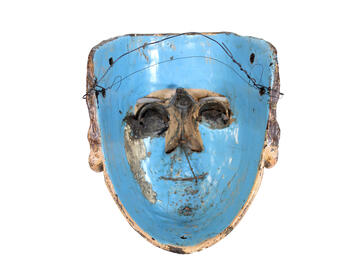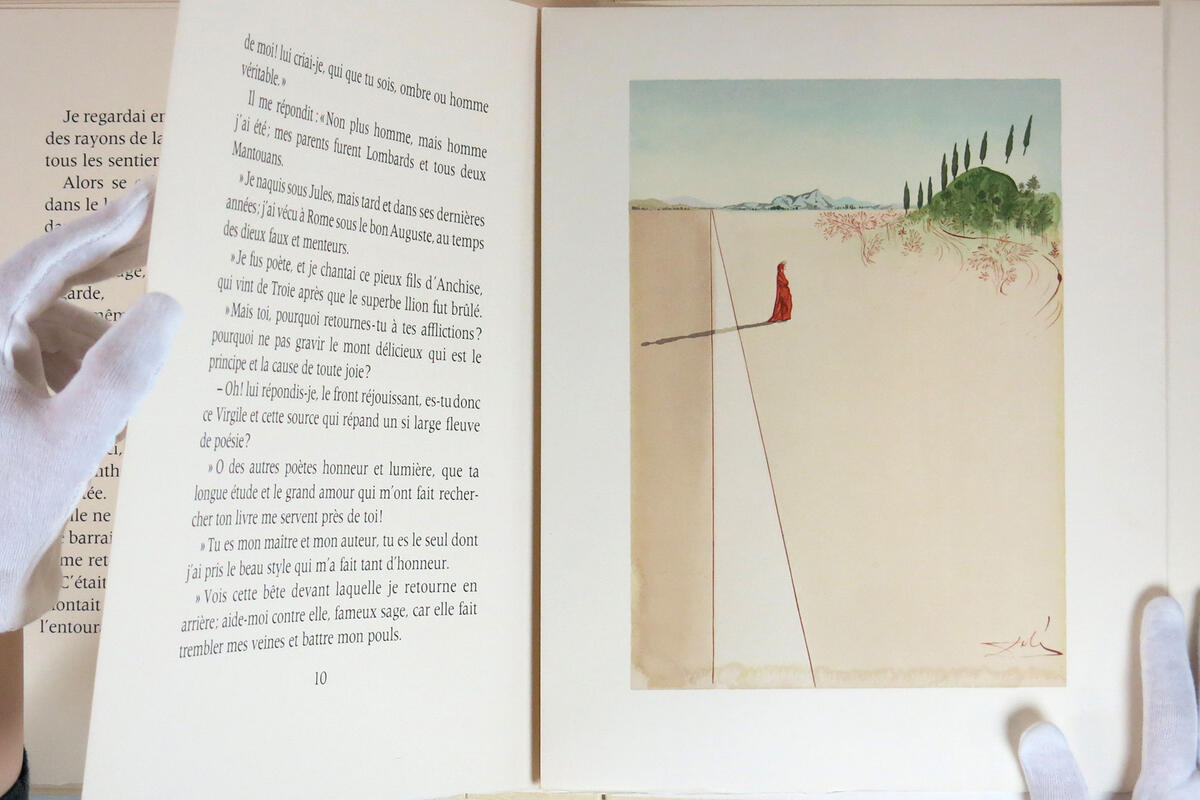Nancy J. Uscher, dean of the UNLV College of Fine Arts, and the UNLV Marjorie Barrick Museum of Art will host a public reception marking the Barrick's 50th year of service to the Las Vegas community, 5 p.m. to 8 p.m. on Friday, Jan. 27. The reception is free and open to the public.
Among the exhibits are:
- Lobby: Fifty Years, organized by Allen Linnabary, Barrick staff and UNLV graduate history student. Special thanks to Richard Zwiercan, Kathleen Marx, and Aaron Mayes from UNLV University Libraries Special Collections and Digital Collections.
- Main Gallery: Process, curated by Matthew Gardocki
- Braunstein Gallery: Masking, curated by Karen Roop
- Teaching Gallery: Abandon All Hope, Ye Who Enter Here, curated by Lee Cannarozzo
About Fifty Years
To celebrate the 50th anniversary of the Marjorie Barrick Museum of Art, we have assembled a display incorporating newspaper clippings from as early as 1969, historic photographs spanning several decades, and artifacts from the Michael C. and Mannetta Braunstein Collection. Fifty Years explores the fascinating story of the Barrick Museum from its genesis in a modest building opposite UNLV on Maryland Parkway to the beginnings of its current incarnation as a principal venue for contemporary art in the Las Vegas area. The exhibit will be on display in the Museum's lobby beginning in 2017.
About the Barrick Museum
Uniquely located inside one of the university’s three original buildings, the UNLV Marjorie Barrick Museum of Art is entering its 50th year of service to the Las Vegas community. We regard this milestone as an unparalleled opportunity for growth and change.
Our goal is to develop a core collection of contemporary artists with ties to southern Nevada into an unprecedented asset to art scholars, historians, and Las Vegans from all walks of life who are searching for a deepened sense of pride in their city. Our position within the College of Fine Arts on the UNLV campus provides us with many opportunities to broaden the educational scope of our mission, giving contemporary artists the chance to have their work studied by a wide and questioning audience. Ambitiously, we hope to complement and contribute to the defining of the Las Vegas art world by providing a well-informed context.
Barrick Museum Quick Facts
1967 - The Desert Research Institute establishes a museum to exhibit and house its collections on Maryland Parkway.
1969 - The DRI transfers ownership of its collection to the University of Nevada, Las Vegas.
1975 - The museum raises enough money to move its artifacts to the old gym in the center of campus. The University names the facility the UNLV Museum of Natural History.
1986 - The first contemporary art exhibition comes to the museum.
1989 - The University formally changes the name to the Marjorie Barrick Museum of Natural History in honor of Las Vegas philanthropist Marjorie Barrick and her continued support of the University.
1992 - The University remodels the museum building and adds on the new Harry Reid Center for Environmental Studies
2011 - The Marjorie Barrick loses state funding. Initially threatened with closure, it is saved when it changes focus and integrates with the College of Fine Arts, becoming the flagship location for art on campus. Following refurbishment, it is able to house two important art collections: the Nevada portion of the Herbert and Dorothy Vogel 50x50 and the artworks owned by the Las Vegas Art Museum.
2012 - The Barrick reopens to the public as a contemporary art museum augmented with a permanent collection of culturally significant artifacts.
2016 - In preparation for its 50th anniversary, the Barrick officially becomes the UNLV Marjorie Barrick Museum of Art.

About Process
Featuring work by: John Bauer, Christopher Duncan, Kara Joslyn, Lester Monzon, Julie Oppermann, Kim Rugg, Christopher Russell, Heidi Schwegler, Meghan Smythe, and Ryan Wallace.
Process is a showcase of ten contemporary American artists who are reshaping the Process Art tradition into a profound expression of twenty-first century studio practice. The exhibition will include painting, photography, mixed media, and sculpture.
Rooted in Dada and performance theater, Process Art is a conceptual framework that allows the intangible act of creation to be made perceptible in the finished artwork. It played a key role in the careers of pioneering twentieth-century art world figures such as Joseph Beuys, Eva Hesse, Bruce Nauman, and Richard Serra. Following in their footsteps, the artists of “Process” have forged eloquent visual languages around the environmental effects of the sun, the retrieval of debris from a studio floor, and the intricate movements that a hand undergoes as it cuts and reassembles postage stamps. Visitors can expect to encounter a fresh and perhaps unfamiliar field of art-making in which process is celebrated and the finished object is not always the principal focus.
Gardocki comments, “I have always been primarily interested in the exploration the artist undertakes, and these works are glimpses into the visual steps that carry each of them along their individual journeys.”
The artists included in “Process” encompass a diverse miscellany of practice:
- Marrying digital manipulation with traditional stenciling, spraying, rolling, brushing, and printing, John Bauer revisits the intimacy of Abstract Expressionist mark-making from a mediated postmodern distance.
- Chris Duncan works in a state of flux between maximal and minimal extremes, using repetition and accumulation as a basis for experiments in visual and sound based media.
- Kara Joslyn teases out the delicate quality of her forms using polymer auto paint applied with a laborious process of masking and airbrushing, calling up tensions between the hand-made and the industrial.
- The paintings of Lester Monzon gently lampoon the notion of a fixed context by collapsing architecture, space, and art history into a tête-à-tête between rigid grids and gestural marks.
- Julie Oppermann uses flickering, juxtaposed imagery to push the limits of visual perception, creating paintings that are physically difficult to perceive.
- By satirically dissecting and re-appropriating medium and meaning, Kim Rugg highlights the innately slanted nature of information distribution.
- Christopher Russell disturbs settled surfaces with scratches and haze, evincing the kinds of outlier memories that plague our psyche well after childhood.
- By mining the peripheries for discarded objects Heidi Schwegler creates bodies of work that inhabit an equilibrium between endurance and decay.
- Meghan Smythe weaves glass, ceramic, and concrete together in an orgiastic web of body parts and biological artifacts, monumentalizing our mortality in unanticipated ways.
- Ryan Wallace forges new abstractions from the detritus of previous works, generating a marriage between cognitive and intuitive ways of thinking.
Matthew Gardocki has been working with artists in Los Angeles for over a decade. Co-founder of the quarterly pop-up exhibition 5790 Projects and the Igloo Tornado collective, he joined Mark Moore as a Gallery Director in 2010. From 2012 - 2013 he was a regular contributor to Fabrik Magazine’s “Emergent Presence” column, recommending LA-based artists he thought everyone should know. Currently he is the Gallery Director at DENK in Los Angeles, CA. All works are courtesy the artists and Mark Moore Fine Art .

About Masking
This exhibition combines traditional Mexican masks with contemporary artwork to blur the lines between art and artifice, self and other, being and nonbeing. Far from static artifacts, masks point to shifting meanings and challenge us to question notions of identity.
A native of Nevada, Karen Roop has taught courses in English ranging from Composition I to Early American Literature at UNLV, Austin Community College, and the University of Texas, Austin. As assistant director of English composition, she oversees and teaches ENG 101 and co-teaches ENG 791, a practicum for new graduate teaching assistants in the English department. Her enthusiasm for new ways of diversifying UNLV’s English curriculum has led to years of fruitful collaboration with the Marjorie Barrick Museum, where students have learned to assimilate the visual arts into their critical vocabularies. Roop will integrate Masking, her first curation, into ENG 101 classes during the Fall semester.
About Abandon All Hope, Ye Who Enter Here
Abandon All Hope, Ye Who Enter Here is an exhibition of two complete editions of Salvador Dali illustrated artist books: The Divine Comedy written by Dante Alighieri and The Decameron written by Giovanni Boccaccio. These books, completed in 1960 and 1972 respectively, together contain 110 prints authorized by the artist. A part of the Las Vegas Art Museum collection currently housed in the UNLV Marjorie Barrick Museum of Art, this exhibition presents these illustrated texts in a dynamic manner. Contained within four display cases, the pages of these books will be turned every Tuesday and Friday throughout the course of the exhibition to reveal a new set of illustrations to the public. This constantly evolving exhibition is an invitation for students, scholars, and faculty to view these surreal works of art and to participate in a conversation about the cultural resonance of Medieval Italian texts.
A native Las Vegan with a professional background in figurative oil painting, Lee Cannarozzo has been working with the UNLV Marjorie Barrick Museum since 2015. Earlier this year at the Donna Beam Fine Art Gallery he curated Disconnected: the History of an American Phenomenon, an ambitious exhibition featuring selections from the Neon Museum’s collection of classic Las Vegas signage. Lee Cannarozzo is completing his senior year in Art History at UNLV. His current practice focuses on conceptual art manifested through installations, land art, and non-traditional mediums.
The Barrick believes that art has a fundamental place in teaching and learning across all disciplines. We are pleased to present the Teaching Gallery as an opportunity to explore the role works of art play across the University, and to teach us all.






